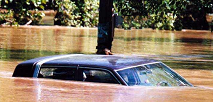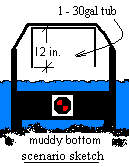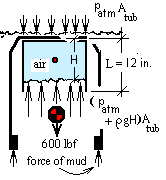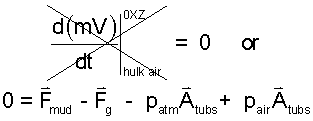| THERMO Spoken Here! ~ J. Pohl © | TOC NEXT ~ 98 |
Abandoned Car
While cleaning trash from an estuary, students discovered an abandoned car exposed only at low tide. They decided to remove the eyesore.

Their plan was to insert inverted steel washtubs inside the car at low tide. With the bottoms of the tubs against the roof, incoming tidal water would trap air inside the tubs and float the vehicle. Once floated, the car body would be dragged to much deeper water then sunk from sight.
With not much thought, we realize we cannot determine if the plan will work. If the hulk had been there a long time, it might be full of mud and who knows what. So we will not be able to prove this task possible. Can we prove anything? Yes. We can perform calculations to establish if the plan will fail. If we make some sweeping assumptions that favor the event and the calculations say "no," then we can state with certainty that the plan will definitely fail.
The car body has no motor nor wheels; it weighs about 600 pounds. Assume there is no mud within the car. The wash tubs are 2 feet square and one foot in depth. Although the volume of the car material will help it float, that volume is unknown and difficult to calculate. So we assumed the worst case; no help with floating, and no buoyancy, the car with volume assumed to be zero. The bottom of the car might be under mud and the tires stuck. So we must further assumed no problems with mud, no "sticking" effects whatsoever. This is indeed a rosey picture.

How Many wash tubs will be needed to float the abandoned car?
♦ A scenario sketch (right) shows the car with one inverted washtub in place. When the tide is out, the weight of the hulk is supported at its bottom by mud. As the tide comes in, estuary water traps air in the tub. According to Archimedes, the lifting force of the trapped air is greatest when the greatest amount of water is displaced. So the greatest lift force will occur when the inverted tub is just submerged (when the tide is about level with the roof of the car). If the car does not lift then, the lift force will decrease as the tide gets higher. Lets see if one tub is enough. The steps of the solution are:
Free Body Diagram: The hulk, immediately before it lifts (we hope) is in mechanical equilibrium. To apply the momentum equation requires a carefully drawn free-body-diagram (right).

Momentum Equation:: The Z-component of the momentum equation is:

| (1) 1 |
Mass Equation : The mass equation for the air trapped under the tubs as our system is:

| (2) 2 |
Since the air will behave as an ideal gas mixture we can write the above as:

| (3) 3 |
The lifting process will last about an hour as the water level of the tide rises. Consequently the air in the tubs will always have the same temperature as the sea water. We assume the water temperature to be constant. The process will be isothermal. Thus our mass equation with the ideal gas equation of state for air becomes:

| (4) 4 |
Lastly, the hydrostatic equation (momentum applied to a column of sea water adjacent to the trapped air) is written. This equation will tell us the pressure of the water beside the air which is also the pressure of the air:

| (5) 5 |
A method of solving these equations is to use 2) and 3) to solve for H
Answer: H = 0.97 ft.
Now return with H to 3) to determine:
pairAtubs = 8,716 lbf.
Finally we put those numbers into the momentum equation 1) to calculate the force of the mud Fmud. If the force of the mud is positive (upward), mud is still supporting the car so it will not lift. But if the force of the mud is negative, the car will float (provided it is not stuck in the mud).

| (6) 6 |
So for one tub the supporting force of the mud is 351 lbf. This means the car won't float, more tubs will be needed. The calculation with three inverted tubs is:

| (7) 7 |
Great! If three tubs are used, either the mud maintains a downward force (pull) of 147 lbf on the car, or the hulk will float.
Abandoned Car

While cleaning trash from an estuary, students discovered an abandoned car exposed only at low tide. They decided to remove the eyesore.
Their plan was to insert inverted steel washtubs inside the car at low tide. With the bottoms of the tubs against the roof, the incoming tide would trap air in the them and float the vehicle. Once floated, the car body would be dragged to much deeper water then sunk from sight.
Premise presently unwritted!